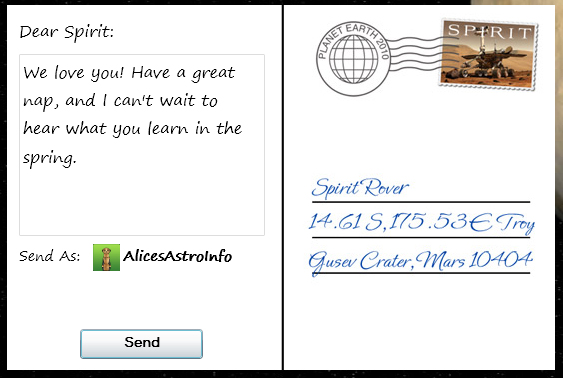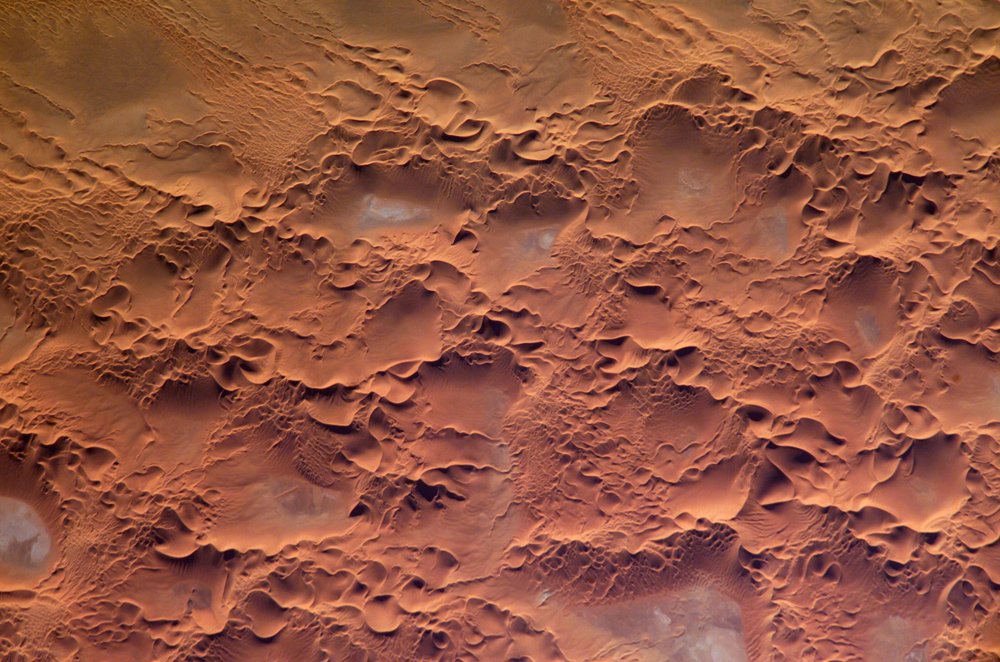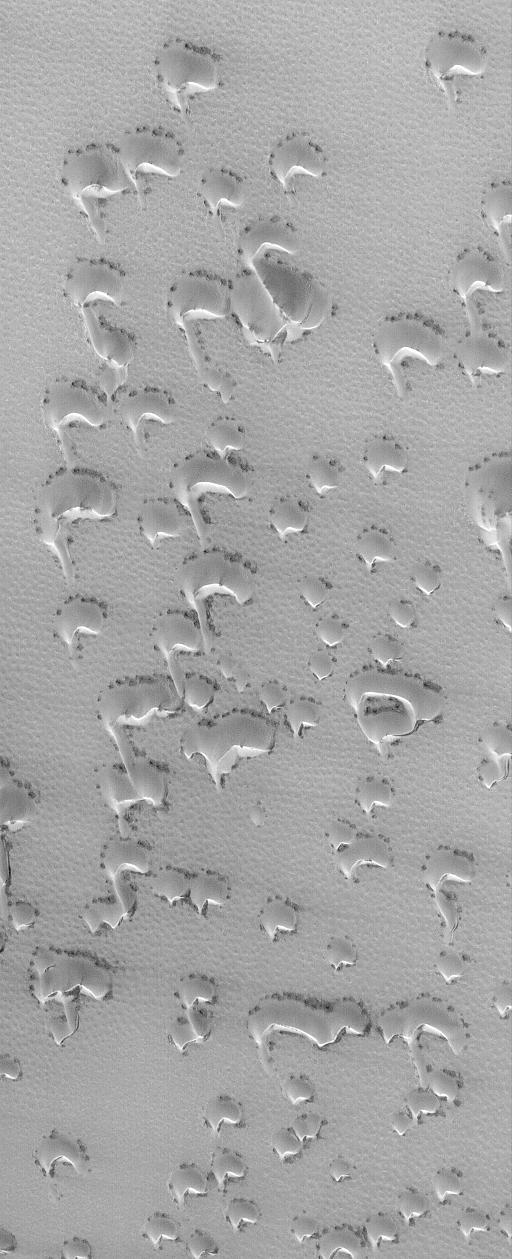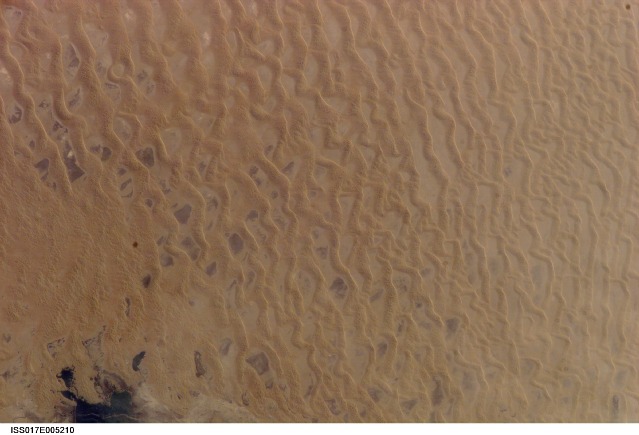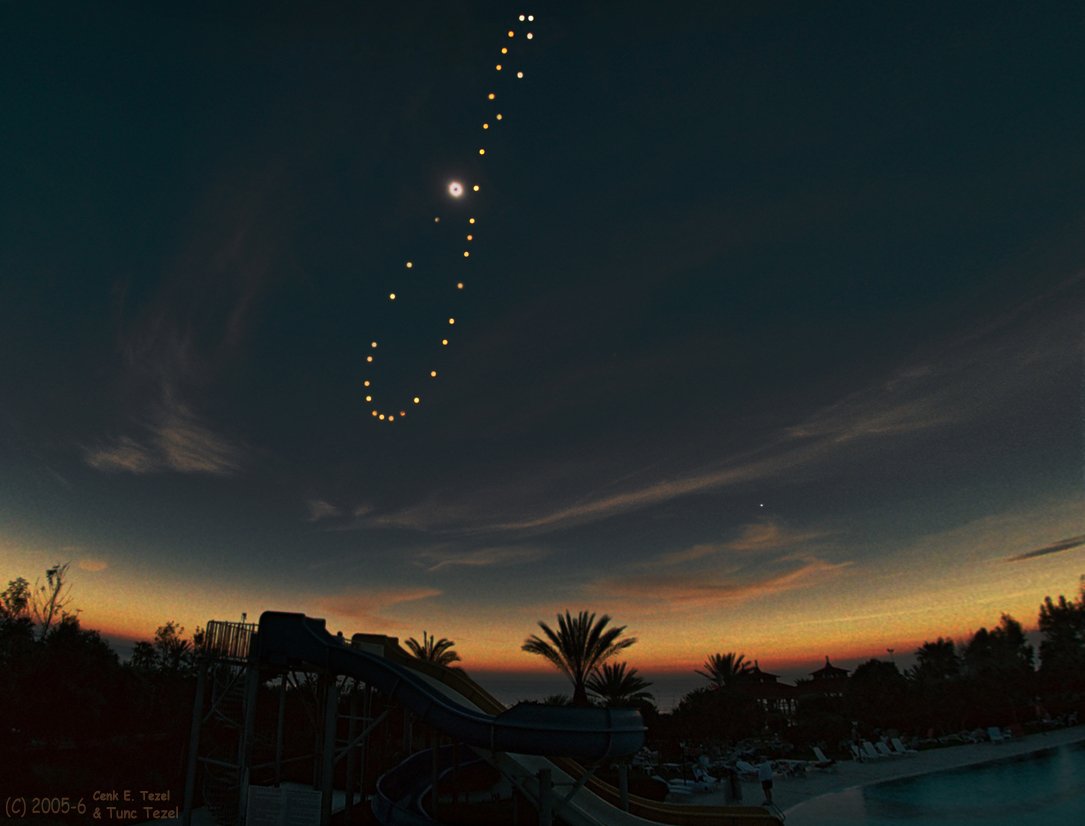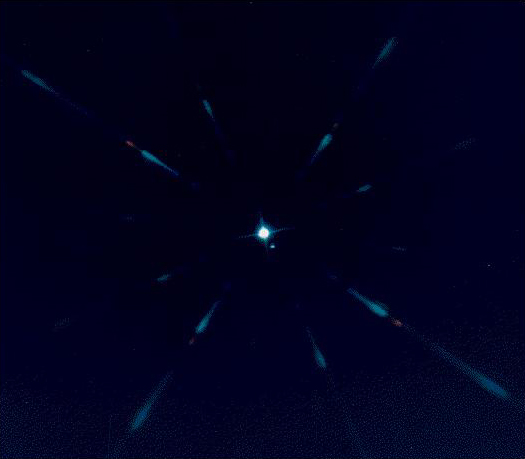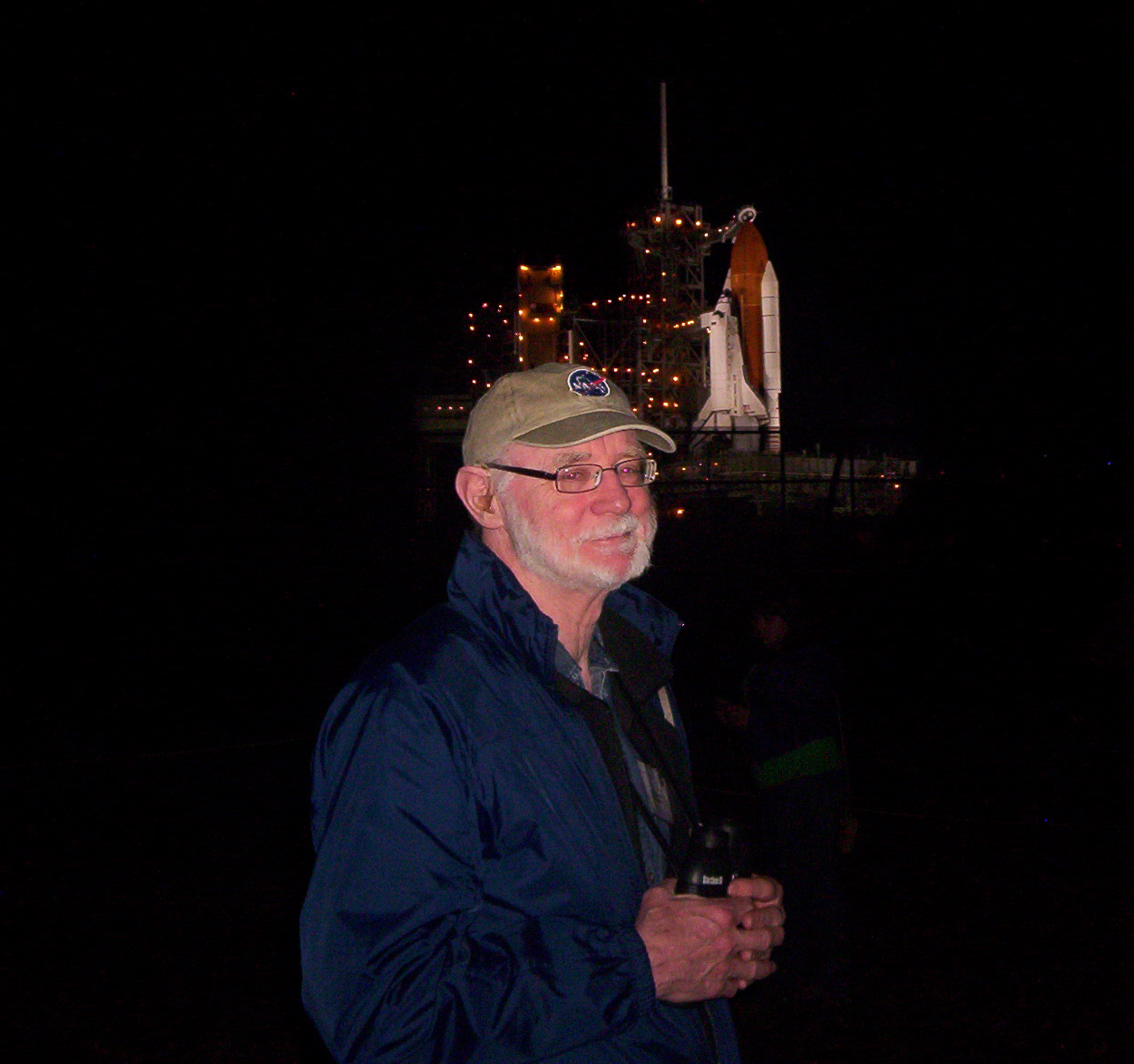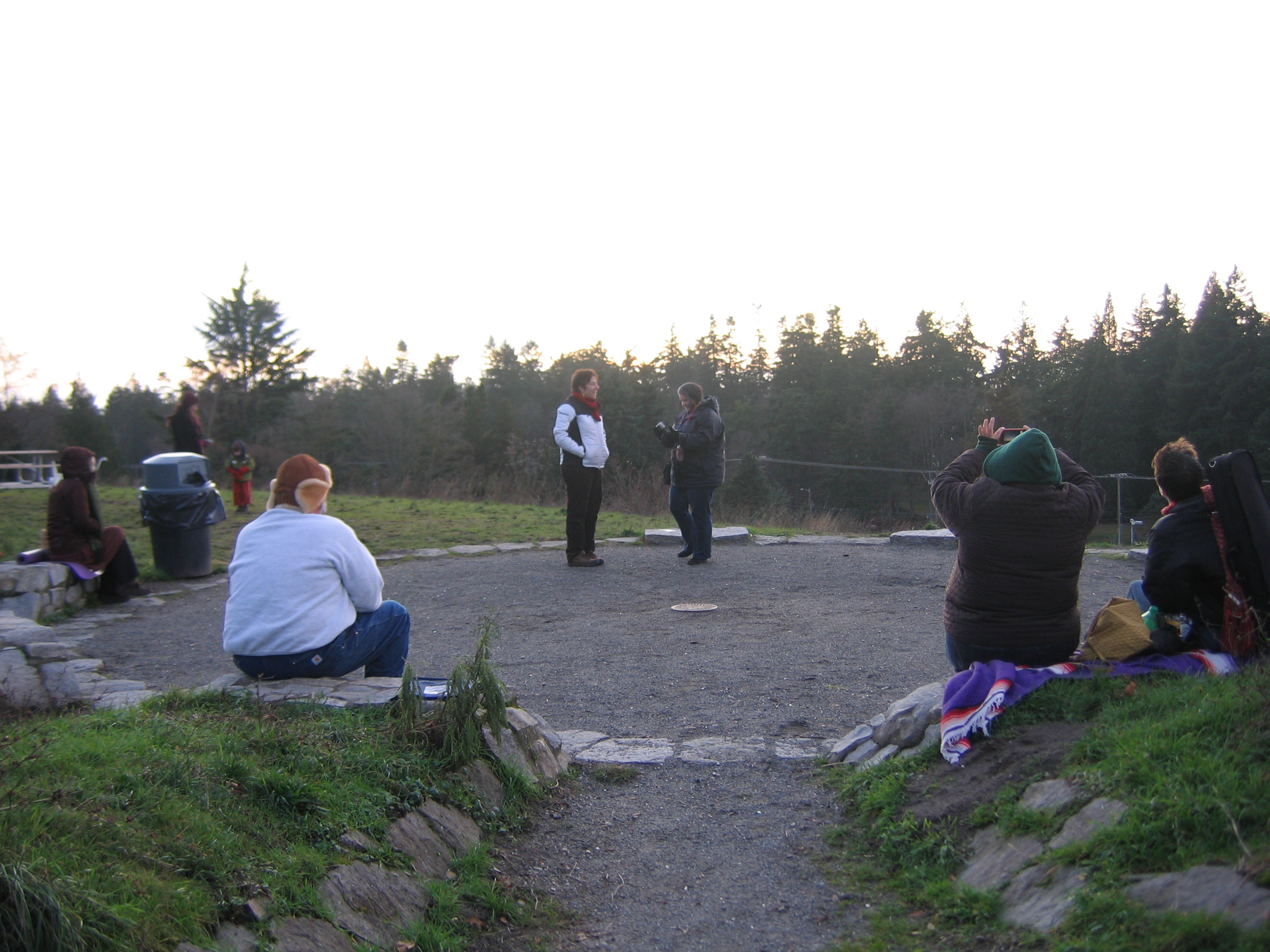 Stationary Science: Spirit at Troy
Stationary Science: Spirit at Troy
Well, the “Free Spirit” campaign is over, she’s staying at Troy. Doug McCuiston, the director of the Mars Exploration Program says “We do not believe that Spirit is extractable.” He maintains that they might free her by accident, but the goal now is to position the solar panels to make it through the Martian winter, so she can wake up in spring and begin some amazing cool new stationary science.

SIMULATED (but none-the-less-awesome) Image from Stuart Atkinson http://cumbriansky.wordpress.com/2010/01/26/a-very-big-day-for-spirit/
Positioning for Winter
Most important now, is making sure Spirit has enough power to keep her instruments warm. Currently her solar panels are tilted slightly away from the Sun. The team is trying to back Spirit a little ways up the hill behind her, which would point the panels towards the Sun. They have already succeeded in moving her backwards about 20 cm, so hopes are high that she’ll get to the best possible position.
A note on “backwards” – Spirit normally drives backwards, and when she got stuck she was driving backwards in the southerly direction. As they move her now, they are still moving her backwards and south – attempting to back her up the hill.
Emily quotes John Callas (project manager, Mars Exploration Rovers) who says they “estimate 3 weeks of driving activity, handful of drives left. Around March-April will be last images before winter hibernation.”
Upcoming Science
Just because she’s stationary does not mean Spirit is done. The team has plenty of science planned for her including:
- “Fully characterizing” (studying in depth) the soil around her. The soil is full of sulfate salts which geologists think formed in fumaroles (steam vents).
- Watching the long-term and seasonal changes in a specific location on Mars.
- Working on determining if Mars has a solid or liquid core (I missed the “how” of this, but it may have something to do with the last experiment they mentioned:
- If Spirit sends out a continuous radio signal, we can monitor that signal closely which will allow us to get a very detailed map of Mars’s orbit, rotation, and precession (wobble in the axis of rotation). We can’t do this with a rover, only with a lander.
Send a Postcard to Spirit
JPL has set up a website where you can “send” a postcard to Spirit, and see what others are sending her. Check it out! Here’s mine:
Want More?
Now a Stationary Research Platform, NASA’s Mars Rover Spirit Starts a New Chapter in Red Planet Scientific Studies – NASA Press Release.
What Season is it on Mars? – Emily’s wonderful calendar, and a program to determine the time anywhere on Mars.
![]()
~ A l i c e !
 Mars Calendar
Mars Calendar
Thank you Emily Lakdawalla!
I’m always trying to figure out what season it is on Mars, and she’s got it all calculated out. Check out her detailed and easy to reference Mars calendar.
A Sneak Peek
| Northern Spring / Southern Autumn | Northern Summer / Southern Winter | Northern Autumn / Southern Spring | Northern Winter / Southern Summer |
|---|---|---|---|
| 2009 Oct 27 | 2010 May 13 | 2010 Nov 13 | 2011 Apr 09 |
That data is entirely from Emily.
Look for the next post on Freeing Spirit.
![]()
~ A l i c e !
 Martian Adventures: A Tale of Two Robots
Martian Adventures: A Tale of Two Robots
Opening today!
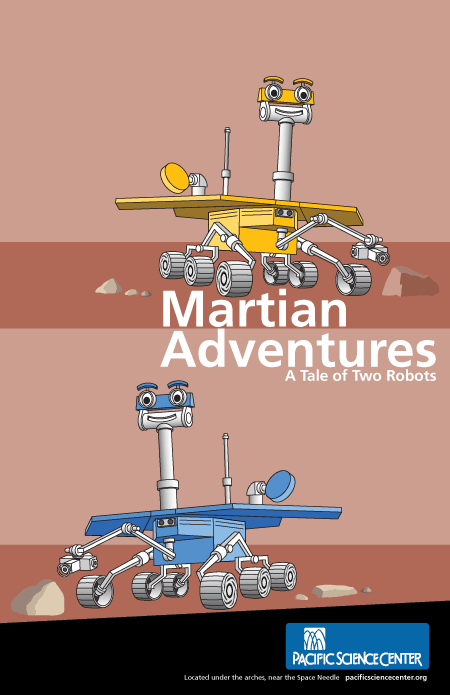
To go along with Pacific Science Center’s Facing Mars exhibit and Roving Mars IMAX film, we’ve created a new planetarium show.
Come hear stories about the adventures of NASA’s Mars Rovers, Spirit and Opportunity. Make your own decisions regarding some of the challenges they’ve faced and learn to find Mars in tonight’s sky. View photos of the Martian surface that are less than a week old, and root for the rovers to keep on roving! Ticket required (FREE tickets for Pacific Science Center members!) 40 minutes – ages 4 and up. Children under 4 are not admitted.
Go to pacificsciencecenter.org for plenty more information about the exhibit and both shows.
RSVP to our Facebook event, and show your support!
When is it Showing?
Some further notes on the show:
Since we wanted a show to complement Facing Mars, I tried to write a show that encompassed the experience of the journey to Mars and what you might face while there – just as the exhibit does. Unfortunately, we have not yet sent people to Mars so I decided to focus on the two robots, Spirit and Opportunity, who seem to have captured the hearts and imaginations of people all over the world. Somehow Spirit and Opportunity (or “Oppy” as we call her) have become beloved pets through whom we can visit a small portion of this alien world.
We were also trying to avoid just another “Red Planet” show, a show listing the most commonly-known facts about Mars: it’s red, it’s got the largest volcano in the solar system, it has the largest valley in the solar system, it has seasonal dust storms, etc. Even if you didn’t already know those facts, you’ll find them in almost any book, TV show, or movie about Mars. We wanted our show to be different.
I also recently attended a storytelling workshop with Jay O’Callahan, who wrote the incredibly moving story of NASA’s first 50 years, “Forged in the Stars”. Good storytelling transports us into the story, and Jay is a master at that. I was inspired by the workshop to begin writing “fact-tales” as my co-worker Michael Bowers calls them; thus “Martian Adventures: A Tale of Two Robots” was born. I cannot claim to be anything like the master that Jay O’Callahan is, but the planetarium staff have taken the stories I outlined and turned them into exciting adventure stories, weaving their words so you hope along with mission control that the rovers will persevere.
The show isn’t all fact-tales though, this is Pacific SCIENCE Center, and “interactive” is one of our watchwords. During a portion of the show guests get to conduct their own analysis of the surface of Mars. We update the show every week with the very newest pictures from the rovers, pictures so new there aren’t usually press releases from the scientists explaining them. So, you get to be the scientist. The planetarians will lead you through the photos asking you to make scientific observations and put forth your own hypotheses about what you see in the pictures. A warning about this for people who need to know “the” answer: the planetarian will not be able to tell you what the best answer is. As I said above, the scientists haven’t had a chance to release their findings about these pictures. That’s what I love about this portion, if you want an answer you have to think of one that matches all the clues you see, you have to be a scientist. You can always check NASA’s website in a few weeks and see what conclusions the scientists have come up with.
I intended this show to appeal to young and old alike, but the story sections might be a little long for children under six or seven. Also, as usual, children under four are only admitted to Preschool All-Stars – our short show expecially for preschoolers and their families. I recommend Martian Adventures: A Tale of Two Robots for anyone who likes discovering and stories.
Oh, and of course we show you where to find Mars in tonight’s sky!
![]()
~ A l i c e !
 Dunes on Mars – New HiRISE Images
Dunes on Mars – New HiRISE Images
Oh the beauty that can result in faraway places untouched by human interference:
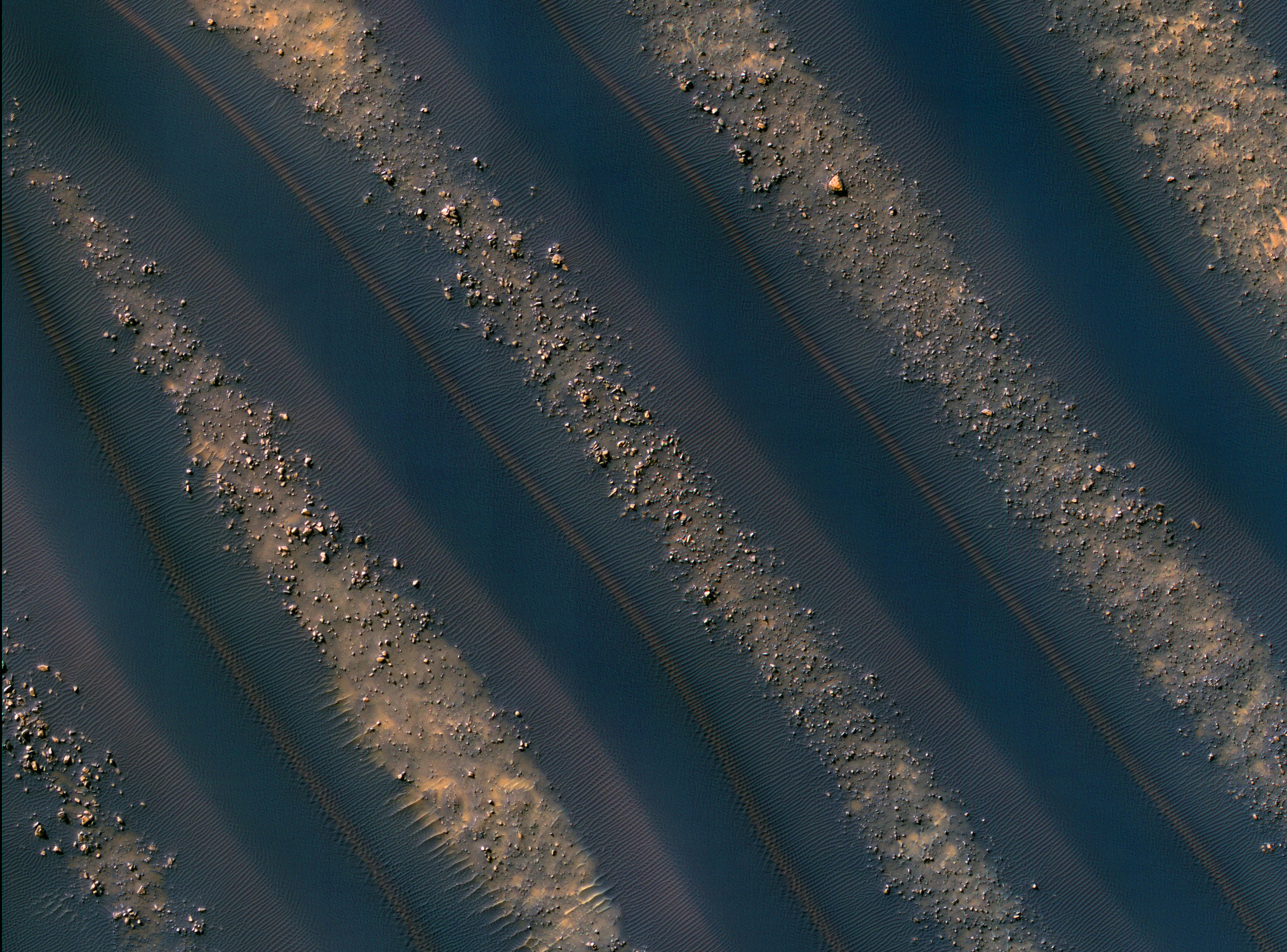
Dunes from a crater in Noachis Terra, west of the giant Hellas impact basin. Image credit: NASA/JPL-Caltech/University of Arizona
I’m getting so excited about Facing Mars coming up at Pacific Science Center. Just a little over one week to go! So, to keep myself entertained, I’ve been looking at some new Mars stuff.
The 10-Second Summary (What you need to know)
- First, click to make that picture bigger. You’ll be amazed at the detail. The boulders are in between the dunes.
- Second, dunes are common on Mars, being a planet covered in dust and sand.
- Third, Mars Orbiter (home of the HiRISE instrument) was not functioning for a while there, but it started working again – and this picture is one of the new ones (from late December 2009). HiRISE is a camera that takes some of the most detailed and breathtaking images we’ve ever seen. It can see the rovers’ tracks from orbit – it is that good.
About Dunes
There are a few basic types of dunes, and they all depend on the angle and changeability of the angle of the wind, the surrounding landscape (are there trees? mountains? bushes?), and the size of the particles that make up the dune.
Longitudinal Dunes
Longitudinal dunes tend to form parallel to the primary wind direction. The picture above from HiRISE is a perfect example of longitudinal dunes.
Star Dunes
Star dunes occur in areas with widely shifting wind directions.
Parabolic Dunes
Parabolic dunes occur in an area where the wind direction is constant, and their open side faces into the wind.
Crescent (Barchan) Dunes
Crescent or barchan dunes occur in an area where the wind direction is constant, and their open side faces away from the wind. They are very easy to confuse with parabolic dunes.
Transverse Dunes
Transverse Dunes are very similar to Longitudinal Dunes – except that they form perpendicular to the wind, not parallel. You’ve seen “dunes” like this – the waves in the sand are created by the water in the same way the wind creates these larger transverse dunes.
Want More?
The Mars Orbiter HiRISE Press Release (more detailed info on the above picture itself)
![]()
~ A l i c e !
 Dark Days of Winter: 365 Days of Astronomy
Dark Days of Winter: 365 Days of Astronomy
Ahh! I found the original post – it had slid back to 2009! Here it is …
By now my first podcast for 365 Days of Astronomy should be live, and here is the post to support it – containing links and images I mention in the podcast. So go listen already!
Also, please excuse the terrible run-on sentences and immense number of “now”‘s in the transcript. I tried to write exactly what I said, and the way I speak is significantly messier than the way I write. And I always thought I wrote the way I spoke. Hmm.
Transcript!
Telephone ring.
Hello, this is Alice. Oh hey hi, I’m glad you called. Yeah, yeah you’re right. Yesterday, January 3 was perihelion – the Earth’s closest point to the Sun. Pretty cool that that happens in winter, isn’t it? Yeah, I know, kinda mind-blowing.
Anyway the real reason I wanted you to call, I wanted to talk about the fact that January 3 was also the latest sunrise of the year. Yeah no, not December 21 the solstice, but January 3. Yeah, I always thought that the latest sunrise and the earliest sunset took place on the solstice because that’s the shortest day therefore it should have the latest sunrise and the earliest sunset. That makes sense, right? But it’s not true! The earliest sunset takes place weeks before the solstice, round about December 6th here in Seattle. That’s the earliest sunset. And the latest sunrise isn’t all the way until January 3.
So it’s kinda weird about why this is. It has to do with this thing called the equation of time. Now, you can represent the equation of time as and equation, but you can also see a representation of it by looking at an analemma. So let me tell you a little bit about how you get an analemma.
Start with noon. Think about where the Sun is at noon. Point out the window, where is the Sun at noon? Now, I hope you’re not pointing straight up because most people in the world don’t actually get to see the Sun straight up over their heads at noon – ever, any time of the year. Now, there are some. Everybody who lives between the Tropics of Cancer and Capricorn gets to see it at least one day out of the year. But the rest of us, we don’t get to see it. Generally it is going to be, if you’re in the Northern Hemisphere, it will be directly above South. Some number of degrees above South will be the highest point that the Sun gets to. And if you live in the Southern Hemisphere it will be some number of degrees above North that you’ll be able to see the Sun at noon.
Now, when it gets to that highest point in its path across the sky, that’s called astronomical noon. That’s the definition of astronomical noon. Next time you see it right there at its highest point look at your watch: probably isn’t reading noon, because we have time zones and all kinds of things like that. But also, even more importantly, that’s not the noon that really matters.
We’ve got two different kinds of time that we’re dealing with. Apparent solar time, which is what I just told you about. It’s noon when the Sun is at the highest point in the sky. You can read this with a sundial a little bit, you can also read it by measuring the angle of the Sun and making sure that it is exactly halfway across its path across the sky. So you’ve got apparent solar time, but you also have mean solar time. Now, mean solar time is what we really use in terms of determining the number of hours that have really passed. Mean solar time is if you took a clock, a perfect clock, and on the vernal equinox, March 21, you set that clock to noon the second you saw the Sun cross over the meridian – the second you saw the Sun get to its highest point – and then you let that clock run for a year, at the end of that year on the next vernal equinox, March 21, when that clock reads noon, the Sun will be right there exactly where it should be: at its highest point. Okay, so that’s mean solar time. It means that we’re averaging it out over a year.
Now the Sun, as we move around the Sun, it appears to move a little faster or a little slower through our sky because of the equation of time. Most of this is because of the eccentricity of the Earth’s orbit around the Sun. We’re not orbiting in a perfect circle. A little bit of it has to do with the tilt of the Earth, so it’s really a pretty complicated little equation, but the effects are interesting and fun.
So, we have the equation of time affecting how fast the Sun is moving across the sky. (Yes, it’s not the Sun moving, but effectively, from our point of view, while we’re watching the Sun rise and set it looks to us like the Sun is moving.) So, effectively, as the Sun is moving across the sky, some days of the year it moves a little slower and some days it moves a little faster. So, when noon comes, some days it’s behind where it should be. It’s not yet at its highest point. And some days its in front of where it should be, not yet at its highest point or, oops, past being at its highest point actually.
Now, with your perfect watch, if you go out, you set up a camera, and you take a picture of the Sun every day at noon by your perfect watch, what you’re going to see, when you put all those pictures together, is a figure-8 shape. That is the analemma, it is also a great representation of the equation of time. Okay, now if you don’t want to spend a year waiting to see that picture, just Google “analemma” or you can stop by my website: www.alicesastroinfo.com, and I’ll put up a picture for you. Also 365 Days of Astronomy will have a link up to my website from their website if that’s easier for you.
So, how does the equation of time make the earliest sunset happen before the solstice and the latest sunrise happen after the solstice? Let’s get back to that. It’s because the entire day is shifting a little bit. And I keep wanting to say it’s shifting left to right because I’ve laid out the hours on a number line, and that’s how I’m visualizing this. So, why don’t you visualize it with me? And I found it a little too complex to lay out the entire number line for a day, so I’m just using the numbers one through ten: they’re representing hours. I’m pretending we have a ten-hour day. Instead of a 24-hour day, we’ve got a ten-hour day. We’ve just got a number line: one through ten. Also, you’ve got ten fingers, so if you’re sitting on the bus, you can just hold your hands out in front of you and you’ve got that number line that you can look at.
Now, think about this: if we’ve got a solstice that’s four “hours” long, it starts at “three” and it ends at “seven.” So, the Sun rises at “three” and it sets at “seven”. So noon is at “five” there. Okay? So we’ve got a pretty short solstice day there. Now, I’m not even going to go into minutes. I’m going to say everything changes by whole hours. The day after the solstice has to be a little bit longer. So instead of being four “hours” long, it is going to have to be at least five “hours” long. All right? And, let’s go with the one that has the latest sunrise. So let’s say the sunrise is just an hour later so instead of our solstice starting at “three” we have our day starting at “four” and then you’ve got to count a five “hour” day beyond that: six, seven, eight, nine – so the Sun sets at nine. So we’ve shifted our entire day to the right.
Let’s do earliest sunset, okay? So the earliest sunset, to get our earliest sunset it’s going to have to happen before “seven” so it will have to happen at “six” which means our sunrise is going to have to happen at “one.” Now remember, these aren’t real hours we’re working with because we’re just doing a ten-hour number line. I’m just showing you how the whole day is shifting left to right. But, from “one” to “six” is once again a five-hour “day” instead of that four-hour “day” that our solstice was. And our solstice does not have the latest sunrise or the earliest sunset like that. Now, in the real world we have to deal with a lot finer methods of measuring, and it turns out these sunsets are only off by a couple of minutes from each other.
And you can look this up. I get a lot of my information from the U.S. Naval Observatory. They have a couple of great resources: one is “Sun and Moon Data for One Day,” they’ll also give you an entire year’s worth of sunrises and sunsets if you’d like, and so you can look at those. They also have a really great post called “The Dark Days of Winter” which is where I got a lot of the information for this so check that out. But in Seattle, that earliest sunset is 4:18pm. The sunset on the solstice was 4:20pm – so we’re not talking about a big difference here.
Alright, well, we’ve talked about a lot of things today. Lot of vocabulary words, and I hope you go and look some of them up. If you have any more questions give me a call. I will talk to you later. Okay, yeah. Bye!
And in case you didn’t catch that, my name is Alice Enevoldsen, I’m the planetarium specialist for Pacific Science Center in Seattle, Washington – pacificsciencecenter.org and the writer for Alice’s AstroInfo alicesastroinfo.com.
Pictures!
Links!
Vocabulary Words!
Blerch. I used a lot of jargon in that podcast, but if you weren’t taking notes and remembered that there was a word somewhere in there that you wanted more info about, here are some of the main ideas.
Equation of Time
Analemma
Perihelion
Astronomical Noon
Tropic of Cancer
Tropic of Capricorn
Mean Solar Time
Apparent Solar Time
Meridian
Eccentricity
Today is also the first day of winter quarter, wish my students and me luck on our three-month journey.
![]()
~ A l i c e !
 Cooking In Space
Cooking In Space
As you may or may not have figured out, one of my other interests is baking, as well as eating yummy food.
What better for the holidays than a post all about cooking in space? Turns out, although most astronauts rehydrate and reheat the packages of food, one astronaut at least experimented with combining those foods and ways of cooking in space. Check out Nancy’s story about Astronaut Sandy Magnus and her adventures in preparing holiday food – over at Universe Today.
You can also look into Sandy’s journal about cooking in space, or stop by my collection of recipes (none of which were ever prepared in space, sadly).
Happy Newtonmas and Merry Christmas!
![]()
~ A l i c e !
 Carnival of Space #134
Carnival of Space #134
Stewart Atkinson of Cumbrian Sky is graciously hosting a holiday Carnival of Space #134. If you don’t go for any other reason, go to see his awesome space-y Christmas tree – it is what I’ve been trying to make mine look like for years. I still haven’t succeeded, though the star on top is a model of a star (our Sun).
Also, thanks to Stu for making sure everyone knows that Alice’s AstroInfo “does what it says on the tin” I think that’s hilarious. I like to think I provide information about Astronomy …
![]()
~ A l i c e !
 January-February 2010 Sky
January-February 2010 Sky
Check out this month’s starmap.
Notable Sky Objects
HEY ALICE, I SAW …
Believe it or not, the answer this month is either Sirius or Mars – and they are in the same part of the sky.
PLANETS
Jupiter is up at sunset, setting around 7pm.
Mars will be up all night, and beautiful. Look midway up in the east around 10pm.
Saturn will be rising in the east around 10:30pm.
Venus will not be visible; it is in the same place as the Sun.
Mercury will also be very hard to find, but it rises just before the Sun, so you have a chance.
EVENTS
January 2 – Perihelion. At 7pm the Earth will be at its closest point to the Sun.
January 4 – Latest sunrise of the year, also Spirit’s 6th anniversary on Mars.
January 25 – Mars Planetarium show opens at Pacific Science Center, also Opportunity’s 6th anniversary on Mars.
January 29 – Mars is at opposition, the best time to observe it.
January 27 – Mercury at greatest elongation, best time to observe Mercury.
January 30 – Facing Mars exhibit opens at Pacific Science Center.
New Constellations
CANIS MAJOR – The Big Dog
SCIENCE: Obviously you’ll need to notice Sirius, the brightest star in the night-time sky, and if you’re wondering about that other one nearby, that’s Procyon. It’s not in Canis Major, it’s in Canis Minor (the little dog), but it’s nearby. If you have a new telescope (or an old one), Sirius might be a fun target, it’s bright enough to find with your scope semi-easily, and it’s a double star, so once you find it look for the teeeeensy-tinsey companion star. (I say “semi-easily” because learning to point a scope takes practice).
MYTH: Traditionally Canis Major and Minor are known as Orion’s hunting dogs, but children today will recognize something else in this constellation. The star Sirius is the inspiration behind the name of J.K. Rowling’s character Sirius Black in the Harry Potter series. Sirius Black is an animagus, a man who can turn himself into an animal. Guess what animal he becomes? Yup – a dog. A big, black dog. She knew her stuff.
According to Dr. Snowder at the Western Washington University Planetarium, the Chinook Tribe sees a canoe race in this part of the sky:
“A big canoe (Orion’s belt) and a small canoe (Orion’s dagger) are in a race to see who can be the first to catch a salmon in the Big River (Milky Way). The little canoe is winning the race. Can you tell which star is the fish? It is the very bright star in the middle of the river (Sirius).”
CANCER – The Crab
SCIENCE: Oh beautiful M44! Messier Object #44, the Beehive Cluster, is in the middle of Cancer. I have been told it’s called the Beehive because it’s full of little triangles of stars which look like bees swarming around.
MYTH: The ancient Egyptians saw Cancer as a scarab beetle – a symbol of life and immortality.
LEO – The Lion
SCIENCE: The star Wolf 359 is in Leo. It’s the third closest star to the Sun – and you might remember it from Star Trek fame – the Battle of Wolf 359, where the Federation attempts to hold off a Borg attack. The other closest stars are Alpha Centauri and Barnard’s Star. It’s too dim to see without a telescope or a camera, but it would be between Leo’s front and back feet.
Gliese 436 (I know, terrible names) is ALSO in Leo. There may be a small Earth-ish-like planet around this one – there’s definitely a Neptune-ish-like planet. We talked about a similar discovery a while ago – and this discovery is by the same team.
MYTH: The Khoisan people of South Africa call Regulus the “Fire Finisher.” It is a star that marks the time of night in the winter. Unfortunately, in the paper I read, the Fire Finisher might also be Antares or Arcturus – depending on which tribe you ask. Regulus is called “G/wi” – and I’m sorry, I can’t help you pronounce that, the “/” is an actual part of the anglicized spelling, because the Khoisan languages are the “clicky” languages of the San (Bushman) people. (This is from Astronomy Across Cultures, a book of scientific papers on traditional astronomy around the world. It’s an awesome book, and VERY hard to get a hold of).
“Tiny” Guys
Going for the Gold? Here’s this month’s itty-bittys.
LEPUS – The Hare
ERIDANUS – The River (Actually, it’s huge, but dim)
CANIS MINOR – The Little Dog
LEO MINOR – The Small Lion (Between the Big Dipper and Leo)
CAMELOPARDALIS– The Giraffe
TRIANGULUM – The Triangle
ARIES – The Ram
SEXTANS – The Sextant
HYDRA – The Sea Serpent (Also big and dim, so big that it may be the biggest Northern Hemisphere constellation)
MONOCEROS – The Unicorn
LYNX – The Lynx
LACERTA – The Lizard
Returning Constellations
ORION – The Hunter
TAURUS – The Bull
GEMINI – The Twins
PISCES – The Fish
ANDROMEDA – Princess Andromeda
PEGASUS – The Winged Horse
CEPHEUS – King Cepheus
DRACO – The Dragon
URSA MAJOR – The Great Bear
URSA MINOR – The Little Bear
CASSIOPEIA – The Queen
Happy Sky Viewing!
Where’d I get my Info?
My memory, and Zeta Strickland
Selin, Helaine ed. Astronomy Across Cultures. Kluwer Academic Publishers. 2000.
![]()
~ A l i c e !
 Jay O’Callahan and the NASA Story
Jay O’Callahan and the NASA Story
THIS is what I’ve been waiting for. Yesterday I received wonderful news in my e-mail. Jay O’Callahan will tell his NASA Story on PRI’s Living on Earth the weekend after Christmas.
This is a well-written and well-told story of NASA’s first 50 years. You should all mark your calendars and drop everything for it.
I heard this story at the Astronomical Society of the Pacific meeting in September, and Jay moved the audience to tears.
Not often do I believe this vehemently that everyone should watch/listen/or read a certain thing. I may say “You gotta see…” or “This is the best ever…” but it is often hyperbole. This though, this you should hear. I assume a recording will come out at some point, but there has been no noise about such and I have not heard of motions in that direction. So, as it stands this MAY be your only chance to hear this story – sometimes things get lost in the sands of time. Tune in, turn it up, and imagine an grey-haired man with graceful hands beginning to spin a tale in for you.
The e-mail:
 |
|
|
Jay’s NASA Story on NPR!
Jay recorded a 48-minute “broadcast” version of his NASA story, Forged in the Stars, before a lively audience for NPR*’s Living on Earth. It will air on Living on Earth the weekend after Christmas. To find out when Living on Earth is broadcast on your local NPR station, go to www.loe.org, click on WHERE TO TUNE IN, then click on your state or go directly to your local NPR station.
You may already have heard a segment of this story called The Eagle Soars on Living on Earth. The upcoming broadcast is the complete “broadcast” version of Forged in the Stars.
Be sure to tune in! Happy Holidays!
|
 
Read about my journey of the creation of Forged in the Stars
Visit Jay’s Website
|
|
Jay O’Callahan, PO Box 1054, Marshfield, MA 02050
800-626-5356, jay@ocallahan.com, www.ocallahan.com |
|
*As pointed out later, Living on Earth is produced by PRI, not NPR.
![]()
~ A l i c e !
 Winter Solstice Sunset – 2009
Winter Solstice Sunset – 2009
- When: Monday, December 21st 4:20pm (so come at 4)
- Where: Solstice Park (or, if you’re not in Seattle, wherever you have a view of the western horizon!)
- Who: Everyone welcome – like the last few events
Come watch the winter solstice sunset Solstice Park in West Seattle on Monday (the 21st). We’ll see if the sunset lines up with the placed marker. I’ll be there even if it is cloudy because sometimes the Sun peeks through just as it begins to set, but if it is driving rain or sleet I’m staying home with a hot cup of tea.
If you’re interested – here’s the timing of various celestial events on Monday from Seattle, courtesy of the U.S. Naval Observatory Astronomical Applications Department
Sun and Moon Data for One Day
Seattle, King County, Washington (longitude W122.3, latitude N47.6):
Monday 21 December 2009 Pacific Standard Time
SUN
Begin civil twilight 7:19 a.m.
Sunrise 7:55 a.m.
Sun transit 12:08 p.m.
Sunset 4:20 p.m.
End civil twilight 4:56 p.m.MOON
Moonset 8:44 p.m. on preceding day
Moonrise 10:44 a.m.
Moon transit 4:11 p.m.
Moonset 9:48 p.m.
Moonrise 11:02 a.m. on following dayPhase of the Moon on 21 December: waxing crescent
Everyone is welcome, see you there!
Oh – and check out this week’s Carnival of Space – #133!
![]()
~ A l i c e !


